Effective Link Building Guide: How to Outsmart Your Competitors
Share
Link building is one of the super effective ways to drive more traffic and improve your SEO rankings for your website. This effective link building guide helps you outsmart your competitors and creates a path to understanding what strategies are available and what you should and shouldn’t do.
You may need to adjust your link-building strategies because it is different for various industries. And get to know about the factors to consider when choosing your link targets, sources, and methods.
In this article, you will learn how to Offer strategies and tactics for building high-quality links with intense competition, where acquiring backlinks can be challenging.
Top 5 Strategies For Building High-Quality Links To Outsmart Your Competitors
You can find opportunities to build relationships with people relevant to business by understanding how and where competitors acquire links. Link building is tough, and if you are not invested in link building, tools like Ahrefs and SEMrush provide the most significant insight into competitor performance. According to recent studies, on average, the most experienced link builders built 25 monthly links.
In B2B, link building is famous, so there may need to be more than just implementing a strategy to grow your website. Produce high-quality content and develop your brand.
High-quality links increase your rankings while also forwarding more direct referral traffic. They have the potential to last forever. Accordingly, one high-quality backlink is often worth far more than many low-quality links. These backlinks strategies are essential and will help you ensure the links you build are of the highest quality.
Now, let’s see the top tactics for building high-quality links to outsmart your competitors,
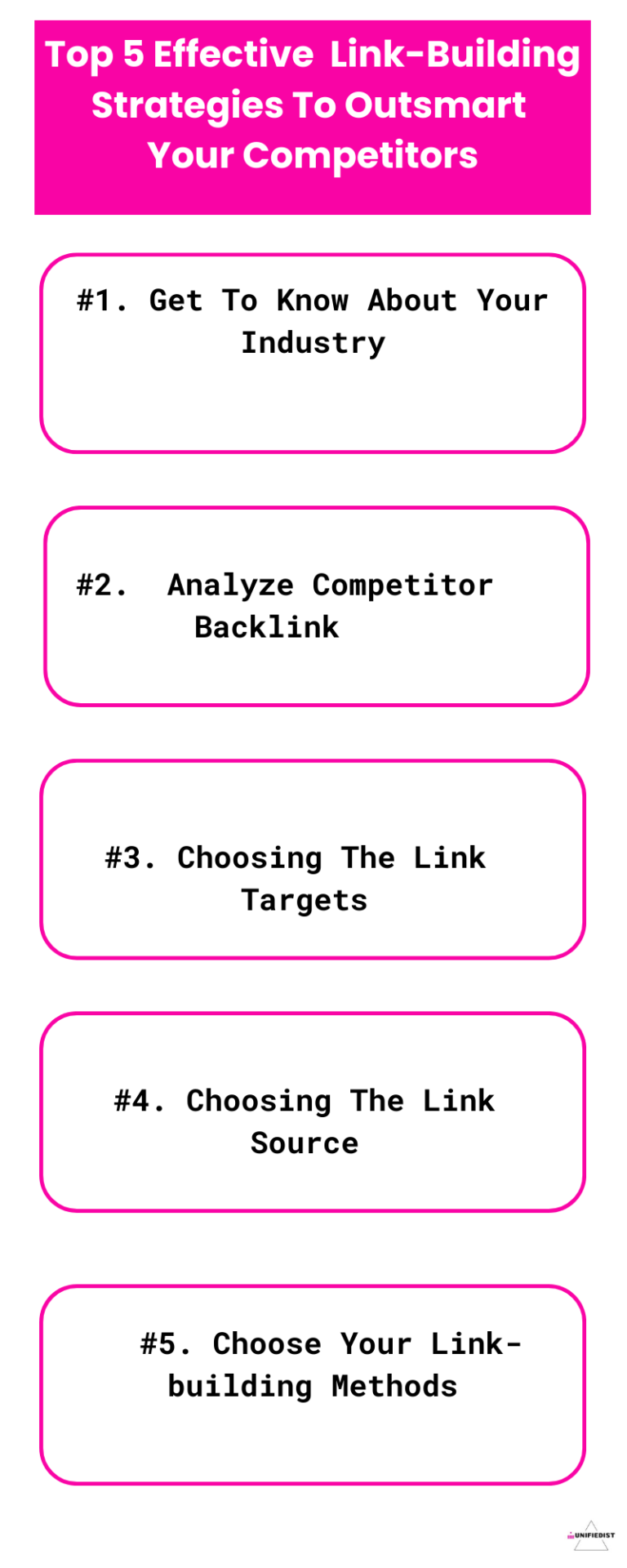
#1. Get To Know About Your Industry
You need to understand your industry and its characteristics before building links. Some industries are more competitive and more niche than others. This kind of industry affects how easy or hard it is to get links from relevant and authoritative websites.
For example, if you are in the finance industry, you may face more regulations regarding linking. Then, you should focus on getting links from reputable and trustworthy sources.
On the other hand, if you are in the fashion or entertainment industry, you may have more creative and viral potential to get links from popular and influential websites.
#2. Analyze Competitor Backlink
When you get the initial research into your industry, competitor backlink analysis is great. It helps you understand the competition and gives you many high-opportunity links. Let’s dive into competitor backlink analysis.
What Is Competitive Link Analysis?
A competitor link analysis is an analysis of the link profiles of the main competitors where you look at their link-building strategies to gain insights. From this, Implement some of the same strategies in your link building, which can lead to higher rankings in SERP and increase sales.
Ways for approaching competitive link building are as follows,
-
First, create a great webpage than your competitor’s. Then, similar to the Skyscraper method, reach out to the referring domain, asking to link to your page instead.
-
Another method is to find links to dead or redirected pages on your competitor’s website. Then, let the referring domain know they are linking to a slow or redirected page; then, offer a relevant page on your website as an alternative.
Competitive link analysis typically has different success rates depending on the nature of the link and involves a lot of manual outreach.
Advantages of Competitor Link Analysis
Some businesses will rely more heavily on resource content or their products for link building. Let’s see some benefits of competitor analysis in any link-building campaign.
#1. Competitor Link Analysis Helps To Identify Your Competitors
Discovering how competitors have compiled links in a given industry provides a roadmap to increase organic visibility online. The first benefit of competitor analysis in SEO is that it allows you to determine your top market competitors.
Thus, as a result, you can assess their market position and conduct additional research. Include both direct business and internet competitors while doing so.
#2. Competitor Link Analysis Helps To Identify Websites That Competitors Are Linking To
Competitor link analysis will help you find out which websites your competitors are linking to but aren’t. As a result, you can create your link profile by adding connections from websites already connected to your competitors.
You should also remember that sites connecting to several competitors will increase your website’s worth. As a result, you should pay special attention to these sites by contacting them and writing guest pieces for them.
#3. Competitor Link Analysis Helps Get The Right Keywords
You can use a keyword gap analysis that your competitors use the most to determine what terms are missing. Keywords are crucial in SEO, and if you see that specific keywords are performing well for your competitors but not for you, it is a good idea to incorporate them on your site.
Discover partnerships and other relationships your competition has formed, and reach out to begin planting your seed.
Tips To Acquire Links Using Competitive Link Analysis
1. Identify Your Competitors
You may already know who your competitors are, and you can use that list later in the process. You can also check out the organic competitors report in Ahrefs’ Site Explorer to find a list of sites ranking for the same things you are.

Image Source – ahrefs
You can search for a few central terms; if you don’t have a website yet, you can tell who the competitors will be. Another way of doing this is to add a few terms to Ahrefs’ Keywords Explorer and go to the traffic share by domains report, showing you which sites get the most traffic for those terms.
2. Find Common Links
To find standard links, take your list of competitors, then enter them in the Link Intersect report in Ahref’s Site Explorer. This process will give you a list of all the referring domains that your competitors have and show how many different competitors have links from those sites.
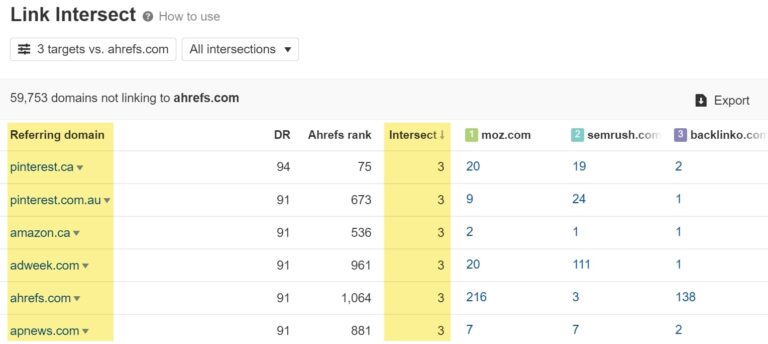
3. Figure Out Competitor Strategies
There are a couple of ways to use this data to determine competitors’ strategies. You can look and work through those at the standard links your competitors have that you’re missing.
To see the type of sites where competitors are getting links, you can look for patterns in the data. You may see things like local listings, the niche of the sites, and other local websites.
#3. Choosing The Link Targets
Now, you have an idea of your industry and your competitors. So now, you need to choose your link targets. Get links from these websites; they should be relevant, authoritative, and trustworthy.
You can use various criteria to evaluate your link targets, such as their traffic, relevance, domain authority, reputation, and content quality. Consider the balance of your link profile and aim for a mix of links, such as editorial, guest post, resource, directory, social media, and forum links.
Techniques for finding link targets
The simple place to start finding link targets is a search on Google. A single search gave us several great lists to search through. The significant advantage of this technique is that someone else has already done your hard work by curating the list.
Once you’ve found a list like this, you can quickly grab all URLs from the page using a tool like Scraper, a Google Chrome plugin. You simply right-click on one URL and click “Scrape similar.”
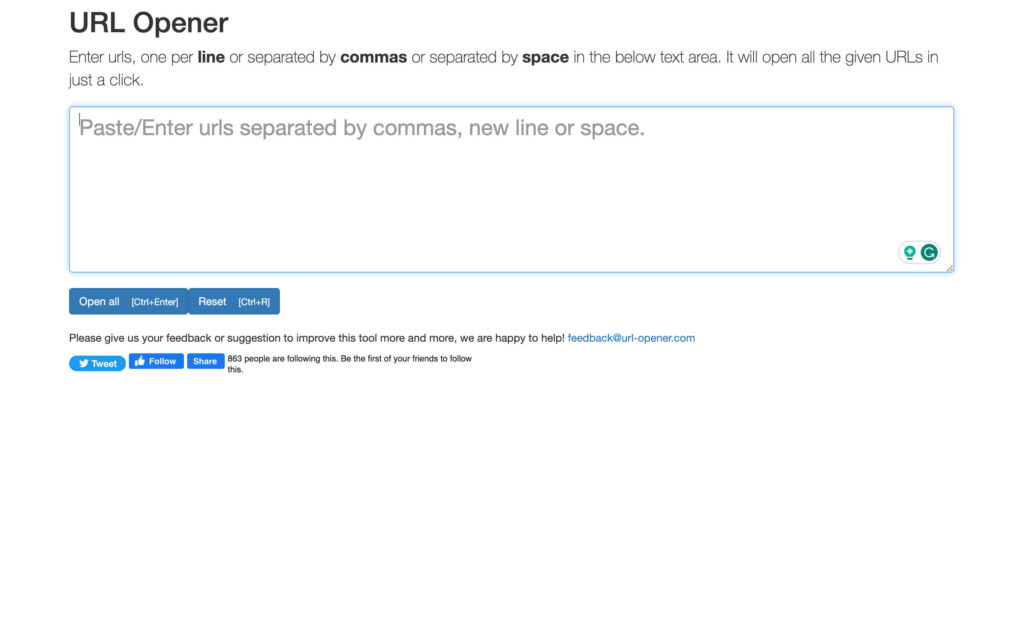
You can then copy the list into Google Docs or your spreadsheet. From here, you can copy and paste all the URLs into a tool like URL opener, which will open all the URLs with one click. You can then review them all to determine their relevance to your content.
#4. Choosing The Link Source
Your link targeting is done, right? After that, you need to choose your link sources. These are the websites you own or control, which you can use to create and distribute content containing your links. You should select your link sources based on your industry, audience, goals, and resources.
You should also make sure that your link sources are relevant, valuable, and engaging for your link targets and their readers. You can use various channels and platforms to create and share your link sources, such as your website, blog, social media accounts, email newsletters, podcasts, videos, webinars, ebooks, infographics, and more.
How Do You Find New Link Sources?
You can find new link sources that are relevant, high-quality, and willing to link to you. Now, Let us learn some practical methods to discover and evaluate potential link opportunities for your site.
Use Google Search Operators
You can use Google search operators to refine your search results and find specific types of sites or pages.
For example, To find sites with your target keyword in their URL or the ‘intitle’ operator, you can use the ‘inurl:’ operator. And help to find sites with your target keyword in their title.
You can also use the ‘site:’operator to include or exclude specific domains or the ‘related:’ operator to find sites similar to a given area.
By combining different operators, you can create advanced queries to help you find places that might be interested in linking to you, such as niche sites, blogs, directories, and forums.
Use Competitor Analysis Tools
Apart from link-building tools available out there, you can easily spy on your competitors’ link profiles and identify their best sources of backlinks with the help of competitor analysis tools and software applications. The most popular tools include Moz, SEMrush, Ahrefs, and Majestic.
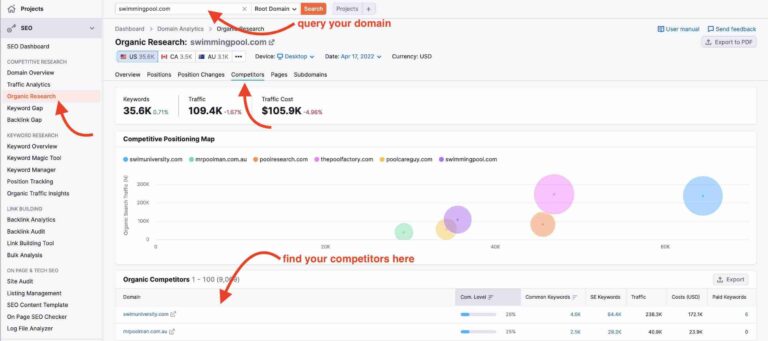
Image Source – Semrush
These competitor analysis tools can show you various metrics and insights about your competitor’s backlinks, such as their domain authority, anchor text, link type, and link location.
You can also use these tools to find out who is linking to your competitors, how they are linking to them, and why they are linking to them. After analyzing this information, replicate or improve link-building strategies and reach out to the same or similar sites.
Use Social Media Platforms
Social media platforms are great for engaging with your audience, promoting content, and finding new link sources. It helps to see what content they share or link to. You can use social media platforms to search for relevant keywords, topics, hashtags, or influencers in your niche.
You can also use social media platforms to monitor mentions of your brand, products, or services and see who is talking about or recommending you. You can use these platforms to build relationships with potential link partners, thank them for their support, or ask them for a link if they still need to give you one.
Use Content Research Tools
Content research tools are software applications that help you find your niche’s most popular and engaging content and see the links they attract. Some popular tools include Ahrefs Content Explorer, BuzzSumo, and SEMrush Content Marketing Toolkit. These content research tools can show you various metrics and insights about the content in your niche, such as their social shares, comments, backlinks, and traffic.
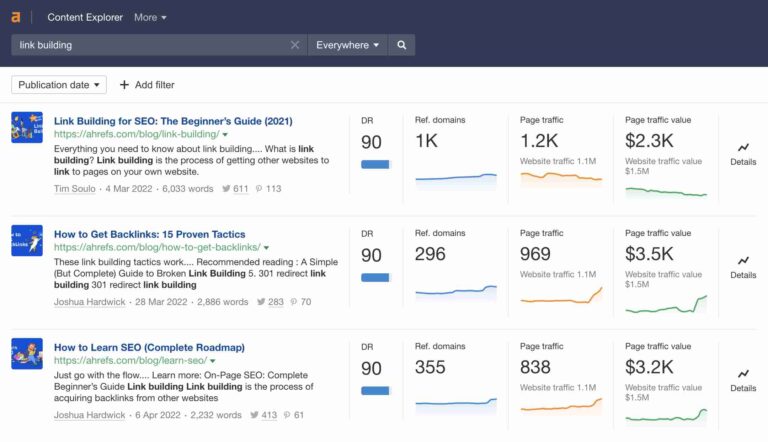
Image Source – Ahrefs
You can use these tools to find out what content resonates with your audience, what content is missing or underrepresented, and what type generates the most links. Then, you can use this information to create better or different content and reach out to the sites linking to the existing content.
#5. Choose Your Link-building Methods
Now, you need to choose your link methods. You use these techniques and tactics to get links from your link targets to your link sources. There are various ways to get links, such as outreach, guest posting, broken link building, skyscraper technique, resource page link building, social media link-building, testimonials, reviews, interviews, roundups, collaborations, sponsorships, giveaways, and more.
You should choose your link methods based on your industry, link targets, link sources, and relationship with them. Always follow the best practices and ethics of link-building and manipulative techniques that may harm your rankings.
Top Link-Building Strategies
Choosing your link-building strategies is crucial, and building one with your end goal is essential. Link building takes time, effort, and patience; you must re-evaluate your strategy to understand what’s working and what’s not working.
Let’s dive into Four link-building strategies that you can implement right now.
#1. Publish Link-Worthy Content
Try to publish link-worthy content that people want to build links to. Link-worthy content most likely sits at the top of the marketing funnel. Most digital marketers want to link to pages relevant to their audience.
The more relevant your page is to their audience, the more likely they will link to it. Link-worthy content is also educational and informational. It solves a common problem or answers common questions an audience might have.
#2. Outreach
Now, you have created link-worthy content, and sharing that content with sites you think would benefit from it is essential. Gaining a backlink from high-authority sites is one way to tell Google that your site is an authority on a subject and acts as a “vote of confidence” from one site to another.
Backlinks bringing new potential customers to your website from different sites can help expand your target audience. Outreach can accomplish many tactics, including press releases to obtain links from relevant sites, promote new content, and seek links in existing content.
You can follow outreach best practices such as,
-
Personalized outreach messages, and stop sending generic messages.
-
Keep it short and relevant. And don’t give the recipient much time to scroll through a long email.
-
Tell them why linking to your site or article is good for them.
-
Always give the anchor text.
#3. Earn Links From News Sites
Many publications have a large audience, some of which are driven to your site, and they are authorities in their space, and a backlink from them can go a long way with Google.
It is essential to consider what is relevant for your business and your target publication. So consider creating a new product, donating to a cause or solution, announcing a new partnership, and offering a scholarship.
After you’ve decided on your tactics, you must pitch your idea to publications, contributors, and other relevant media contacts, which would help if you convince them why your story is essential to their audience.
#4. Technical SEO
Technical SEO is another way to gain links by performing a technical audit on your backlinks. Because Sometimes, links might break and pages go down. Also, you might not be aware that links to your site are no longer working. So, by performing a backlink analysis on your site, you can measure the health of your links and analyze how your backlinks are performing.
Final Thoughts
Analyzing your link-building strategies is a great way to refresh your strategy and find the links that may be helping your competitors the most. Crafting your link-building, content, and keyword strategy is made much more evident with information about the who, what, and why of your competitors’ backlinks. You can also update the link-building statistics to stay on top of the game. With the help of the above strategy and tactics for building high-quality links in industries with intense competition, you can acquire challenging backlinks.

